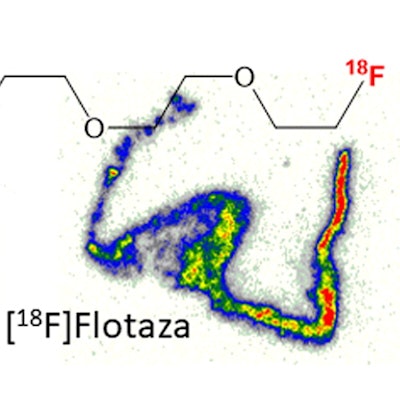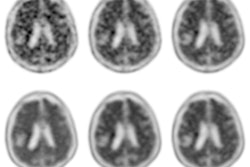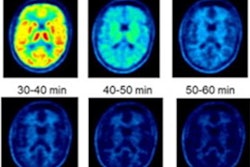
A new PET radiotracer based on previously studied radiopharmaceuticals may improve the detection of beta amyloid plaques seen in Alzheimer's disease, according to a study published in the August (in progress) issue of Bioorganic & Medicinal Chemistry Letters.
University of California, Irvine researchers designed a new radiotracer called F-18 Flotaza based on the most effective components of a previously studied compound and found it identifies beta amyloid plaques clusters more effectively in human Alzheimer's disease brain tissue.
"Although in vitro ratios do not directly translate to in vivo measures, the findings reported here indicate that F-18 Flotaza may be expected to give significantly higher target to nontarget ratios in PET studies," wrote lead author and radiological sciences investigator Jogeshwar Mukherjee, PhD.
The formation of beta-amyloid plaques in certain areas of the brain is an early pathological sign of Alzheimer's disease. The researchers hypothesized that developing new PET imaging tracers to detect these plaques will allow them to develop and evaluate new therapies that targets and reduces beta amyloid plaque, such as Biogen's aducanumab (Aduhelm).
Currently, there are three radiotracers labeled with F-18 approved by the U.S. Food and Drug Administration (FDA) for clinical PET imaging of beta amyloid associated with Alzheimer's disease: florbetapir (Amyvid, Avid Radiopharmaceuticals), florbetaben (Neuraceq, Life Molecular Imaging), and flutemetamol (Vizamyl, GE Healthcare).
Although these F-18 radiotracers offer the advantages of a long half-life, they have a high affinity for binding with white matter in brain areas where beta-amyloid plaque is present, which results in low standardized uptake values (SUV) in the cortex of patients with Alzheimer's disease compared with normal subjects, according to the authors.
"An agent that can provide a significantly higher SUV in the [Alzheimer's disease] cortex may be an improvement towards clinical value," they wrote.
In this study, the researchers combined an F-18 isotope with molecular components of an earlier radiotracer they developed that showed a significant decrease in white matter binding. The chemical name of the new radiotracer is 2-{2-[2-Fluoroethoxy]ethoxy}ethoxy)-4′ -N,N-dimethylaminoazobenzene; hence, the name F-18 Flotaza.
F-18 Flotaza was evaluated in six brain slices the researchers obtained from the Banner Health Research Institute's tissue repository in Sun City, AZ. The slices included anterior cingulate (gray matter) and corpus callosum (white matter) tissue from patients who had Alzheimer's disease when they died.
 Human Alzheimer's disease brain section showing binding of F-18 Flotaza to beta-amyloid plaques. Image courtesy of Bioorganic & Medicinal Chemistry Letters.
Human Alzheimer's disease brain section showing binding of F-18 Flotaza to beta-amyloid plaques. Image courtesy of Bioorganic & Medicinal Chemistry Letters.Brain slices from all Alzheimer's disease patients were positively immunostained with anti-beta amyloid. The ratio of F-18 Flotaza in the gray matter anterior cingulate tissue to white matter corpus callosum tissue samples was greater than 100 in all six subjects. Very little white matter binding was seen. F-18 Flotaza binding in matter anterior cingulate strongly correlated with anti-amyloid beta immunostains, which suggests it is a suitable F-18 PET radiotracer for imaging studies of human beta-amyloid plaques, according to the researchers.
The authors concluded by noting that the radiosynthesis of F-18 Flotaza was simpler because it takes fewer steps than is required with the other F-18-labeled beta-amyloid plaque radiotracers. Moreover, the reagents used to make F-18 Flotaza are not proprietary, as is the case with other F-18 radiotracers, which should enable easier access to it for future research and drug development.





















